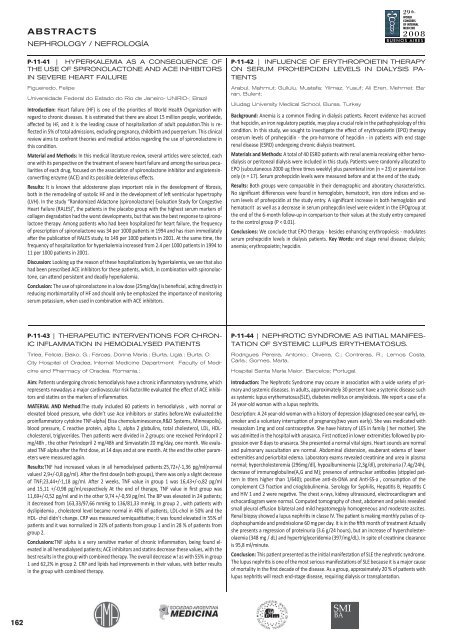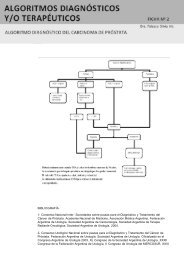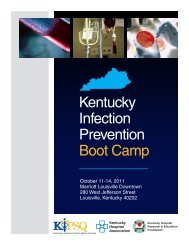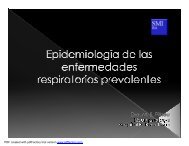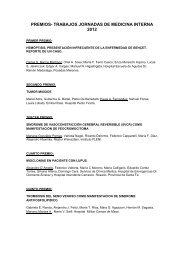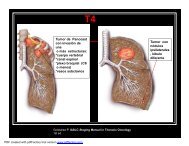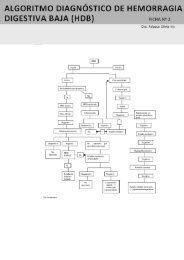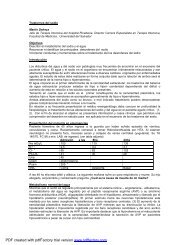Create successful ePaper yourself
Turn your PDF publications into a flip-book with our unique Google optimized e-Paper software.
162<br />
ABSTRACTS<br />
NEPHROLOGY / NEFROLOGÍA<br />
P-11-41 | HYPERKALEMIA AS A CONSEQUENCE OF<br />
THE USE OF SPIRONOLACTONE AND ACE INHIBITORS<br />
IN SEVERE HEART FAILURE<br />
Figueiredo, Felipe<br />
Universidade Federal do Estado do Rio de Janeiro- UNIRIO-; Brazil<br />
Introduction: Heart failure (HF) is one of the priorities of World Health Organization with<br />
regard to chronic diseases. It is estimated that there are about 15 million people, worldwide,<br />
affected by HF, and it is the leading cause of hospitalization of adult population.This is reflected<br />
in 5% of total admissions, excluding pregnancy, childbirth and puerperium. This clinical<br />
review aims to confront theories and medical articles regarding the use of spironolactone in<br />
this condition.<br />
Material and Methods: In this medical literature review, several articles were selected, each<br />
one with its perspective on the treatment of severe heart failure and among the various peculiarities<br />
of each drug, focused on the association of spironolactone inhibitor and angiotensinconverting<br />
enzyme (ACE) and its possible deleterious effects.<br />
Results: It is known that aldosterone plays important role in the development of fibrosis,<br />
both in the remodeling of systolic HF and in the development of left ventricular hypertrophy<br />
(LVH). In the study “Randomized Aldactone (spironolactone) Evaluation Study for Congestive<br />
Heart Failure (RALES)”, the patients in the placebo group with the highest serum markers of<br />
collagen degradation had the worst developments, but that was the best response to spironolactone<br />
therapy. Among patients who had been hospitalized for heart failure, the frequency<br />
of prescription of spironolactone was 34 per 1000 patients in 1994 and has risen immediately<br />
after the publication of RALES study, to 149 per 1000 patients in 2001. At the same time, the<br />
frequency of hospitalization for hyperkalemia increased from 2.4 per 1000 patients in 1994 to<br />
11 per 1000 patients in 2001.<br />
Discussion: Looking up the reason of these hospitalizations by hyperkalemia, we see that also<br />
had been prescribed ACE inhibitors for these patients, which, in combination with spironolactone,<br />
can attend persistent and deadly hyperkalemia.<br />
Conclusion: The use of spironolactone in a low dose (25mg/day) is beneficial, acting directly in<br />
reducing morbimortality of HF and should only be emphasized the importance of monitoring<br />
serum potassium, when used in combination with ACE inhibitors.<br />
P-11-43 | THERAPEUTIC INTERVENTIONS FOR CHRON-<br />
IC INFLAMMATION IN HEMODIALYSED PATIENTS<br />
Tirlea, Felicia; Bako, G.; Farcas, Dorina María.; Burta, Ligia.; Burta, O.<br />
City Hospital of Oradea, Internal Medicine Department Faculty of Medi-<br />
cine and Pharmacy of Oradea. Romania.;<br />
Aim: Patients undergoing chronic hemodialysis have a chronic inflammatory syndrome, which<br />
represents nowadays a major cardiovascular risk factor.We evaluated the effect of ACE inhibitors<br />
and statins on the markers of inflammation.<br />
MATERIAL AND Method:The study included 60 patients in hemodialysis , with normal or<br />
elevated blood pressure, who didn’t use Ace inhibitors or statins before.We evaluated:the<br />
proinflammatory cytokine TNF-alpha( Elisa chemoluminescence,R&D Systems, Minneapolis),<br />
blood pressure, C reactive protein, alpha 1, alpha 2 globulins, total cholesterol, LDL, HDLcholesterol,<br />
triglycerides. Then patients were divided in 2 groups: one received Perindopril 2<br />
mg/48h , the other Perindopril 2 mg/48h and Simvastatin 20 mg/day, one month. We evaluated<br />
TNF alpha after the first dose, at 14 days and at one month. At the end the other parameters<br />
were measured again.<br />
Results:TNF had increased values in all hemodialysed patients:25,72+/-1,36 pg/ml(normal<br />
values! 2,9+/-0,8 pg/ml). After the first dose(in both groups), there was only a slight decrease<br />
of TNF;23,44+/-1,18 pg/ml. After 2 weeks, TNF value in group 1 was 16,43+/-o,82 pg/ml<br />
and 15,11 +/-0,98 pg/ml,respectively At the end of therapy, TNF value in first group was<br />
11,69+/-0,52 pg/ml and in the other 9,74 +/-0,59 pg/ml. The BP was elevated in 24 patients;<br />
it decreased from 163,33/97,66 mmHg to 136/81,33 mmHg. In group 2 , with patients with<br />
dyslipidemia , cholesterol level became normal in 40% of patients, LDL-chol in 50% and the<br />
HDL- chol didn’t change. CRP was measured semiquatitative; it was found elevated in 55% of<br />
patients and it was normalized in 22% of patients from group 1 and in 28 % of patients from<br />
group 2.<br />
Conclusions:TNF alpha is a very sensitive marker of chronic inflammation, being found elevated<br />
in all hemodialysed patients; ACE inhibitors and statins decrease these values, with the<br />
best results in the group with combined therapy. The overall decrease w! as with 55% in group<br />
1 and 62,2% in group 2. CRP and lipids had improvements in their values, with better results<br />
in the group with combined therapy.<br />
P-11-42 | INFLUENCE OF ERYTHROPOIETIN THERAPY<br />
ON SERUM PROHEPCIDIN LEVELS IN DIALYSIS PA-<br />
TIENTS<br />
Arabul, Mahmut; Gullulu, Mustafa; Yilmaz, Yusuf; Ali Eren, Mehmet; Baran,<br />
Bulent;<br />
Uludag University Medical School, Bursa. Turkey<br />
Background: Anemia is a common finding in dialysis patients. Recent evidence has accrued<br />
that hepcidin, an iron regulatory peptide, may play a crucial role in the pathophysiology of this<br />
condition. In this study, we sought to investigate the effect of erythropoietin (EPO) therapy<br />
onserum levels of prohepcidin - the pro-hormone of hepcidin - in patients with end stage<br />
renal disease (ESRD) undergoing chronic dialysis treatment.<br />
Materials and Methods: A total of 40 ESRD patients with renal anemia receiving either hemodialysis<br />
or peritoneal dialysis were included in this study. Patients were randomly allocated to<br />
EPO (subcutaneous 2000 ug three times weekly) plus parenteral iron (n = 23) or parental iron<br />
only (n = 17). Serum prohepcidin levels were measured before and at the end of the study.<br />
Results: Both groups were comparable in their demographic and aboratory characteristics.<br />
No significant differences were found in hemoglobin, hematocrit, iron store indices and serum<br />
levels of prohepcidin at the study entry. A significant increase in both hemoglobin and<br />
hematocrit as well as a decrease in serum prohepcdin level were evident in the EPOgroup at<br />
the end of the 6-month follow-up in comparison to their values at the study entry compared<br />
to the control group (P < 0.01).<br />
Conclusions: We conclude that EPO therapy - besides enhancing erythropoiesis - modulates<br />
serum prohepcidin levels in dialysis patients. Key Words: end stage renal disease; dialysis;<br />
anemia; erythropoietin; hepcidin.<br />
P-11-44 | NEPHROTIC SYNDROME AS INITIAL MANIFES-<br />
TATION OF SYSTEMIC LUPUS ERYTHEMATOSUS.<br />
Rodrigues Pereira, Antonio.; Oliveira, C.; Contreras, R.; Lemos Costa,<br />
Carla.; Gomes, Marta.<br />
Hospital Santa María Maior. Barcelos; Portugal.<br />
Introduction: The Nephrotic Syndrome may occure in association with a wide variety of primary<br />
and systemic diseases. In adults, approximately 30 percent have a systemic disease such<br />
as systemic lupus erythematosus(SLE), diabetes mellitus or amyloidosis. We report a case of a<br />
24 year-old woman with a lupus nephritis.<br />
Description: A 24 year-old woman with a history of depression (diagnosed one year early), exsmoker<br />
and a voluntary interruption of pregnancy(two years early). She was medicated with<br />
mexazolam 1mg and oral contraceptive. She have history of LES in family ( her mother). She<br />
was admitted in the hospital with anasarca. First noticed in lower extremities followed by progression<br />
over 8 days to anasarca. She presented a normal vital signs. Heart sounds are normal<br />
and pulmonary auscultation are normal. Abdominal distension, exuberant edema of lower<br />
extremities and periorbital edema. Laboratory exams revealed creatinine and urea in plasma<br />
normal; hypercholesteremia (296mg/dl), hypoalbuminemia (2,3g/dl), proteinuria (7.4g/24h),<br />
decrease of immunoglobuline(A,G and M); presence of antinuclear antibodies (stippled pattern<br />
in titers higher than 1/640); positive anti-ds-DNA and Anti-SS-a , consumption of the<br />
complement C3 fraction and crioglobulinemia. Serology for Syphilis, Hepatitis B, Hepatitis C<br />
and HIV 1 and 2 were negative. The chest x-rays, kidney ultrassound, electrocardiogram and<br />
echocardiogram were normal. Computed tomography of chest, abdomen and pelvis revealed<br />
small pleural effusion bilateral and mild hepatomegaly homogeneous and moderate ascites.<br />
Renal biopsy showed a lupus nephritis in classe IV. The patient is making monthly pulses of cyclophosphamide<br />
and prednisolone 60 mg per day. It is in the fifth month of treatment Actually<br />
she presents a regression of proteinuria (3.6 g/24 hours), but an increase of hypercholesterolaemia<br />
(348 mg / dL) and hypertriglyceridemia (397/mg/dL). In spite of creatinine clearance<br />
is 95,8 ml/minute.<br />
Conclusion: This patient presented as the initial manifestation of SLE the nephrotic syndrome.<br />
The lupus nephritis is one of the most serious manifestations of SLE because it is a major cause<br />
of mortality in the first decade of the disease. As a group, approximately 20 % of patients with<br />
lupus nephritis will reach end-stage disease, requiring dialysis or transplantation.


